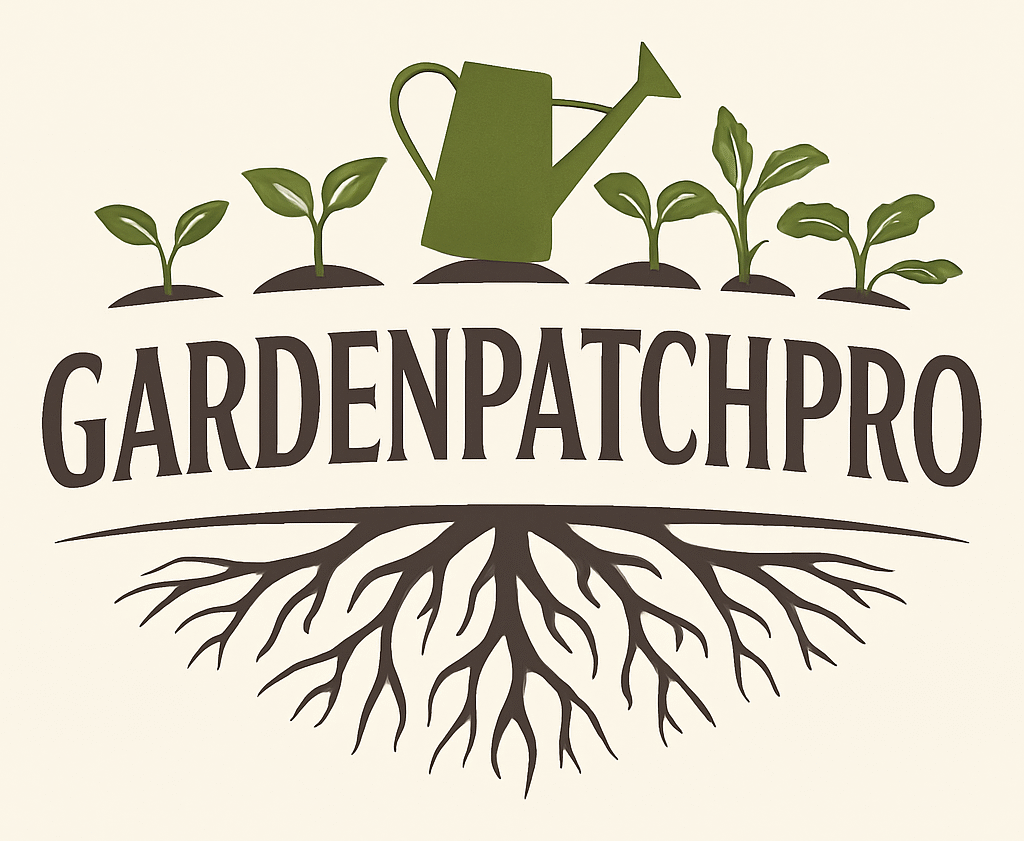14 Backyard Oasis Ideas: Transform Your Outdoor Retreat
Creating a backyard oasis means turning ordinary outdoor space into a relaxing and stylish retreat. It can be simple or elaborate depending on the budget and needs. By using a mix of comfortable seating, greenery, lighting, and thoughtful layout, anyone can design a backyard that feels like a personal escape.

Adding features such as shade options, fire pits, and water elements can enhance comfort and atmosphere. Well-planned zones for dining, lounging, and entertaining help make the space functional for different activities. Privacy and cozy touches make the backyard feel like a true getaway.
Key Takeways
- Outdoor spaces can be designed to offer comfort and style for relaxation.
- Combining different zones and features improves usability and appeal.
- Thoughtful additions create privacy and ambiance for all-day enjoyment.
Transforming Your Backyard Into an Oasis
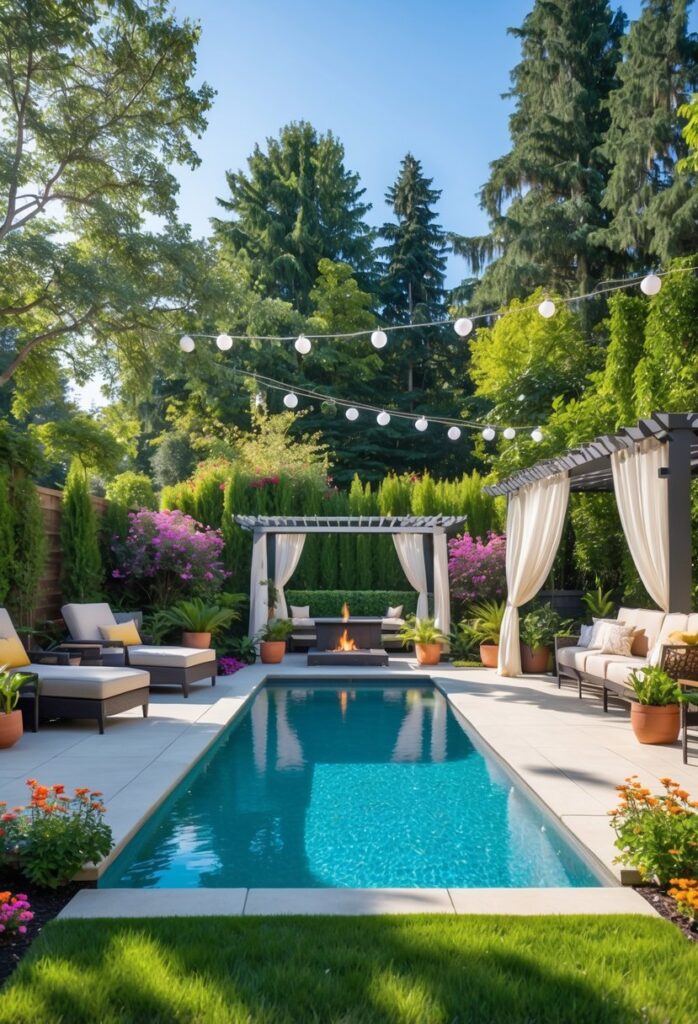
Creating a backyard oasis requires clear decisions about how the space will be used and what features will bring the most value. Thoughtful planning helps balance comfort, style, and function while keeping costs manageable. A well-designed outdoor space includes zones for relaxing, dining, and entertaining, all tailored to personal needs.
Defining the Backyard Oasis
Defining the backyard oasis means deciding its purpose and style. It should fit the homeowner’s lifestyle, whether for quiet relaxation, family gatherings, or outdoor cooking. Clear zones like seating areas, garden beds, or a fire pit help organize the space.
He or she should think about privacy by using fences, plants, or trellises. This creates a sense of enclosure that feels safe and inviting. Adding focal points like a pergola or water feature gives the backyard retreat character and makes it visually appealing.
Planning Your Ideal Outdoor Space
Planning involves choosing the right furniture, lighting, and landscaping. Durable, weather-resistant furniture is essential, especially with cushions and fabrics that dry quickly and resist sun damage. Outdoor rugs and pillows add color and comfort.
Lighting is critical for safety and ambiance. Combining porch lights, pathway lights, and decorative lamps allows flexibility from task lighting during cooking to soft, dim lighting for evening relaxation. Shade options, such as umbrellas or pergolas, provide relief on hot days and extend the use of the backyard.
Plants play a dual role, offering beauty and privacy. Container gardens near seating areas add lushness and can act as natural screens. The layout should allow easy movement while creating cozy, defined spaces for different activities.
Budgeting for Your Oasis Project
Budgeting depends on the scale and features chosen. Basic improvements like seating, plants, and simple lighting can fit modest budgets. A table below shows rough cost ranges for common items:
| Feature | Estimated Cost |
|---|---|
| Outdoor furniture | $500 – $3,000 |
| Lighting | $100 – $1,000 |
| Shade structures | $200 – $5,000 |
| Water features | $300 – $3,000 |
| Fire pits or spas | $1,000 – $10,000+ |
Larger additions like outdoor kitchens or hot tubs increase costs significantly. It is important to plan for maintenance and durability to avoid extra expenses later. Working with a contractor can provide specific estimates and help keep the project within budget. For more detailed ideas and costs, visit 14 backyard oasis ideas from Better Homes & Gardens.
Incorporating Water Features for Serenity
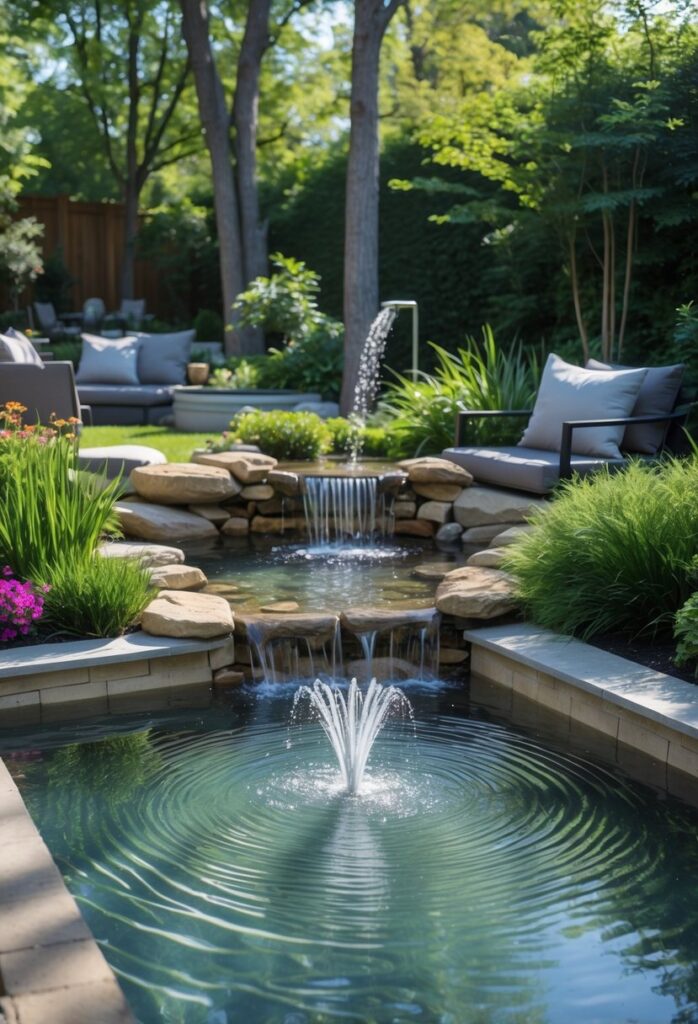
Water features bring calm and beauty to any backyard. They create gentle sounds and visual movement that can reduce stress and improve the atmosphere. Choosing the right type depends on space, budget, and the desired effect.
Choosing a Waterfall or Stone Waterfall
A waterfall adds a natural, peaceful sound to a backyard. Stone waterfalls use stacked flat rocks for a rustic look. They can be built small for compact spaces or larger for dramatic effect.
Water flows over the stones, creating soothing white noise that masks street sounds. Stone is durable and blends well with plants and natural landscaping.
The setup requires a water pump to circulate water from a basin below. It’s important to arrange rocks securely and position the waterfall where it can be easily seen and heard.
Stone waterfalls need occasional cleaning to prevent algae and keep the water clear. This feature works well near seating areas to enhance relaxation.
Adding Fountains and Ponds
Fountains are flexible water features that suit many backyard styles. They range from freestanding models to wall-mounted designs that save space. The flowing water adds sound and life to the garden.
Ponds provide a larger water area and can include fish or aquatic plants. Ponds increase biodiversity and add a visual focal point.
Both features need a water pump for movement and circulation. Fountains require less space and are easier to maintain than ponds. Ponds need proper filtration to keep water healthy.
Placement near patios or pathways helps enjoy the water’s sound and sight. Surround fountains and ponds with plants for a natural look.
DIY Water Feature Ideas
DIY water features can be simple yet effective. A birdbath fountain uses a shallow bowl with a small pump to create gentle bubbling water. It attracts birds and adds sound without much cost.
Container water gardens transform pots into mini ponds with aquatic plants and small pumps for waterfalls. This fits patios or balconies and requires little maintenance.
Bamboo water spouts create rhythmic sounds with water flowing from bamboo onto pebbles. Minimal materials and effort make this a popular choice for those wanting a peaceful vibe.
Solar pumps power many DIY features, reducing energy use and wiring needs. These projects let backyard owners personalize calm water features on a budget.
More on easy backyard water features is available at positivebloom.com.
Creative Backyard Zones for Relaxation

Creating distinct areas within a backyard helps balance comfort and function. Thoughtful zones can include spots for soaking, resting, or casual lounging. This approach makes the space inviting for different relaxation styles and occasions.
Spa and Hot Tub Retreats
A spa or hot tub offers a dedicated place for unwinding. It’s important to choose a location with privacy and easy access from the house. The area needs enough room for safe entry and exit, plus seating around the tub.
Durable, weather-resistant materials for decking or flooring ensure safety and comfort near the hot tub. Adding soft lighting improves ambiance for evening use. Consider overhead shade or a pergola to protect from sun during the day.
Because a filled hot tub can be very heavy, its foundation must be strong and separate from the deck to prevent damage. This zone becomes a personal retreat for soothing muscle tension or social time.
Setting Up a Hammock Haven
A hammock creates a snug, hanging spot for naps or reading. To set one up well, it requires sturdy supports like two trees or secure posts spaced about 10 to 15 feet apart. The ground below should be soft, like grass or mulch, to add safety.
Choosing a weatherproof fabric hammock makes maintenance simple. Accessories like outdoor pillows increase comfort. Positioning near shade helps avoid harsh sun while still catching gentle breezes.
This space is perfect for quiet moments. A hammock haven pairs well with surrounding plants or privacy screens to enhance the feeling of seclusion.
Designing Cozy Lounge Areas
Comfortable lounge chairs form the core of a cozy seating zone. Arranging chairs around a small table invites conversation or relaxation with drinks and snacks nearby. Using cushions and throw pillows adds softness and style.
Materials like wrought iron, synthetic wicker, or teak combine durability with comfort. Rugs made for outdoor use help define the area and add warmth underfoot.
Good lighting is key for this zone to be used after dark. Options include solar lanterns, string lights, or low-voltage lamps. Shade can be provided by umbrellas or a pergola, making the space usable during hot days.
Together, these elements create a versatile spot for relaxation and entertainment.
For more detailed ideas on setting up backyard relaxation zones, see 14 Ideas for Creating a Backyard Oasis from Better Homes & Gardens.
Adding Shade and Shelter Solutions
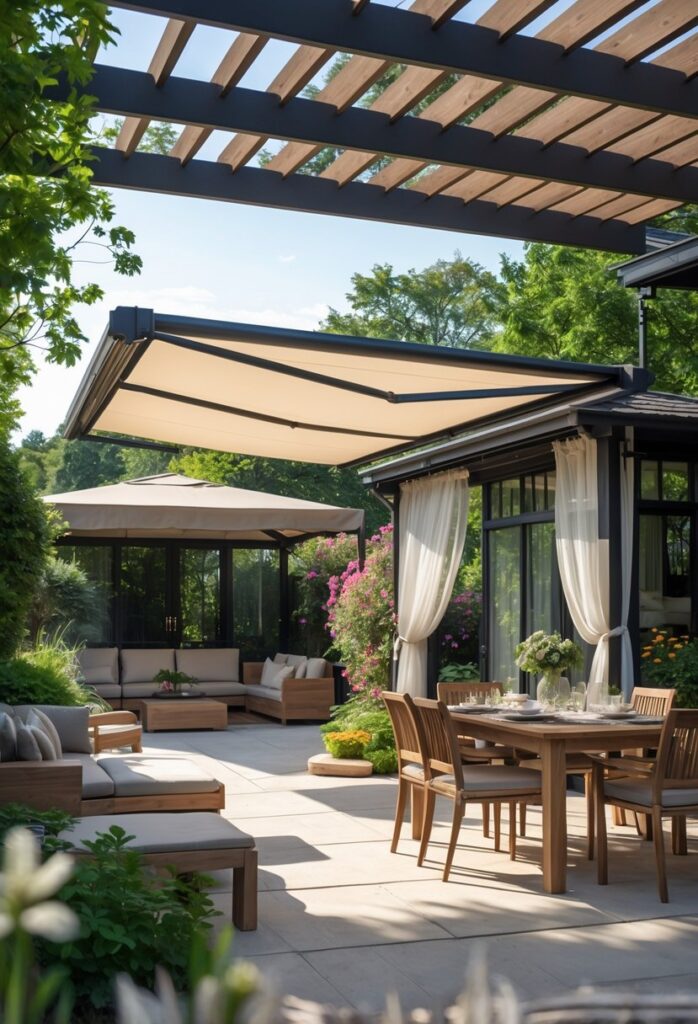
Creating shaded and sheltered areas enhances comfort and usability in a backyard. Selecting the right structures or natural elements can control sunlight and provide protection from weather. These solutions also add style and define spaces for relaxation or gatherings.
Pergolas and Trellis Installations
Pergolas and trellises offer both shade and aesthetic appeal. Pergolas are sturdy structures with open, slatted roofs that filter sunlight, allowing partial shade while maintaining airflow. They work well over patios or seating areas. Adding climbing plants to a pergola or trellis boosts natural shade and softens the design.
Trellises are smaller and commonly used as vertical garden features or privacy screens. When covered with vines, they create shaded spots without blocking views completely. Both pergolas and trellises can be built from wood, metal, or vinyl depending on budget and style preferences.
These installations can define separate zones in a backyard, making outdoor living more comfortable and visually appealing. Maintenance involves checking for weather damage and pruning any plants growing on the structures to keep them healthy and attractive.
Shade from Trees and Canopies
Trees provide natural, eco-friendly shade that cools the backyard effectively. Large, mature trees with broad canopies are ideal for reducing sunlight and lowering temperatures. Planting young trees like maples or oaks allows shade to develop over time. Trees also add privacy and habitat for wildlife.
When trees aren’t an option, fabric canopies offer flexible shade solutions. Shade sails or pop-up canopies can be installed and removed as needed, making them good for renters or temporary needs. These are affordable and come in various shapes and colors to match backyard styles.
Combining natural and fabric shade options, such as placing furniture under a tree with a nearby canopy, can create layered protection from the sun. This approach also adds visual interest and ensures shade where it is needed most.
Creative Use of Pavilions and Awnings
Pavilions are larger, often permanent structures with solid roofs that provide full shade and protection from rain. They make outdoor living spaces usable in various weather conditions. Furnishing a pavilion with seating, lighting, and fans increases comfort and usability.
Retractable awnings are adjustable and mounted to a house or wall. They extend to shade patios or decks and retract when not needed. This flexibility is useful in changing weather and allows control over sunlight and shade.
Both pavilions and awnings can be combined with other elements, like curtains or screens, to offer wind protection or added privacy. Choosing the right size, style, and materials helps match these shelters to the backyard’s overall design and climate needs.
For more ideas, see detailed options on patio shade ideas.
Inviting Lighting for Evening Ambiance
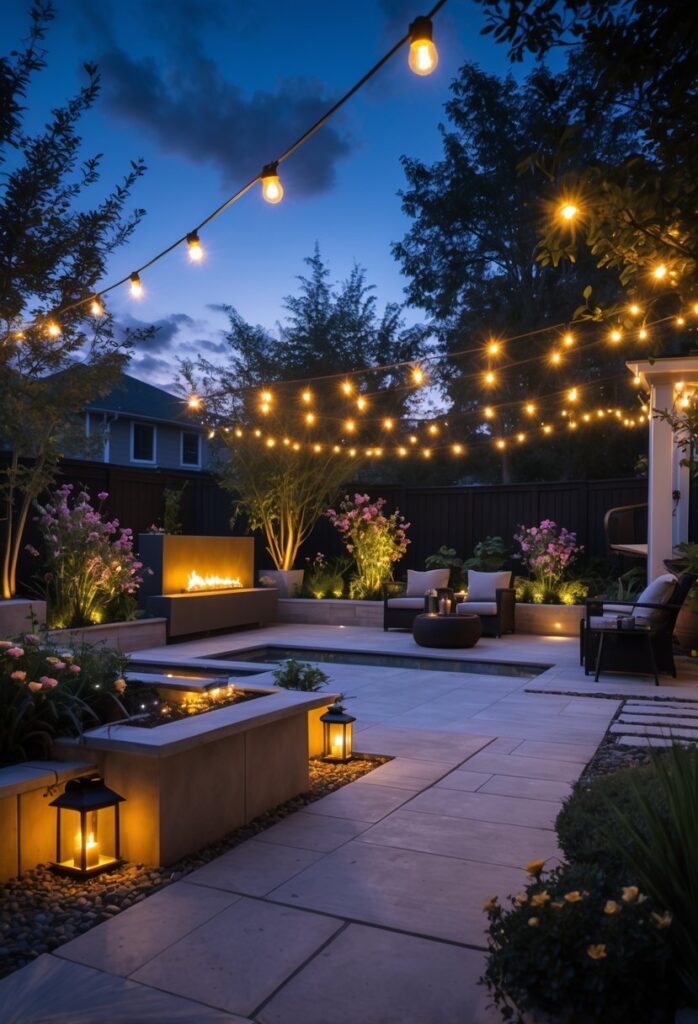
Good lighting can change how a backyard feels at night. It not only adds safety but also creates a warm, welcoming space. Choosing the right kinds of lights helps balance style and function, setting the perfect mood for relaxing or entertaining outdoors.
Using String Lights and LED String Lights
String lights are a popular choice for adding soft, warm light. Hanging them across patios, pergolas, or between trees creates a cozy canopy effect. LED string lights are especially practical because they use less energy and last longer. They come in many colors and styles, from classic white to multicolor options.
Solar-powered LED string lights are easy to install without wiring, making them ideal for energy-saving outdoor use. Their gentle glow is perfect for casual gatherings or quiet evenings. String lights serve both as decoration and practical lighting, softly brightening seating areas without glare.
Incorporating Lanterns and Fairy Lights
Lanterns add a vintage or rustic feel to outdoor spaces. They work well hanging from branches or placed on tables. Battery or solar lanterns offer flexibility in placement and can be moved as needed. Their warm light helps create an intimate atmosphere.
Fairy lights are tiny, delicate lights that bring a magical touch. Wrapping them around shrubs or fencing adds sparkle without overwhelming the space. They often come in battery or solar models, making installation simple. Combining lanterns and fairy lights can create layers of light that enhance the ambiance.
Pathway and Outdoor Lighting Ideas
Pathway lights improve safety by marking walkways while adding style. Solar pathway lights are common since they charge in the sun during the day and shine at night without extra wiring. They come in varied designs, such as classic lantern shapes or sleek stakes.
Other outdoor lighting options include spotlights to highlight trees or sculptures and wall sconces for subtle light on patios or decks. Motion-sensor lights provide security by activating when someone approaches. Planning lighting carefully ensures even coverage of outdoor spaces, improving both visibility and atmosphere.
For more ideas on backyard lighting, see Backyard Lighting Ideas for Evening Entertaining.
Cozy Fire Pit and Gathering Spaces
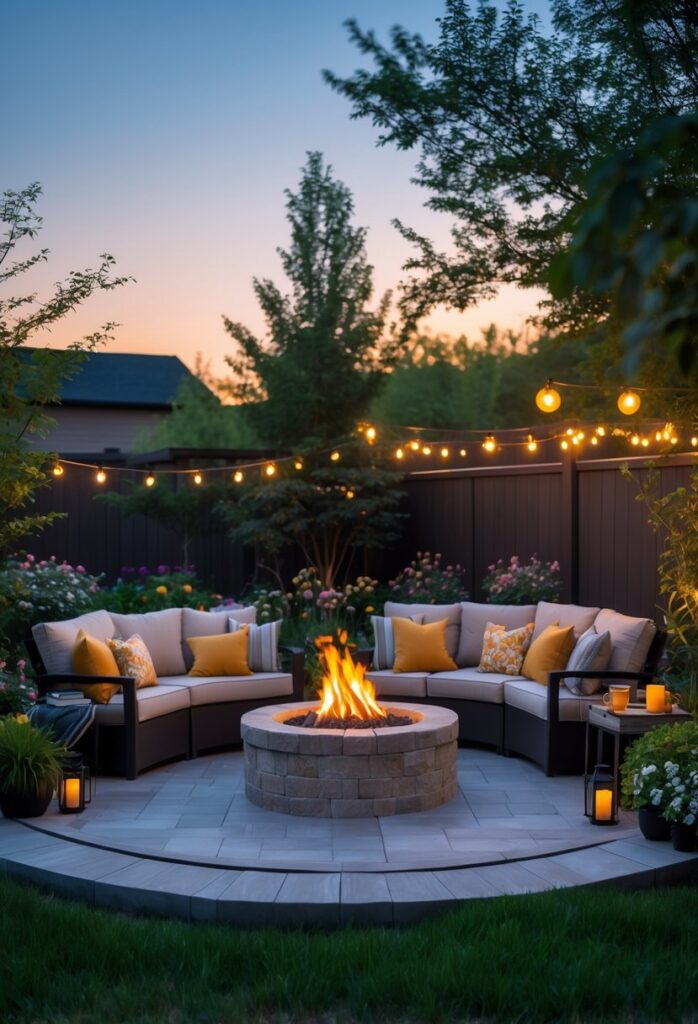
Creating a backyard oasis often centers around a warm, inviting fire pit. The right fire feature and setup can turn any outdoor space into a social hub. Key considerations include fire pit types, design styles, and comfortable seating that encourages conversation and relaxation.
Selecting the Right Fire Pit
Choosing the right fire pit depends on space, style, and function. For smaller areas, a compact gas or propane fire pit provides warmth without overwhelming the patio. Larger yards can accommodate built-in stone or brick fire pits, which add a permanent and rustic touch.
Safety and fuel source matter. Wood-burning pits offer classic ambiance but require more upkeep and safety space. Gas fire pits are easier to control and maintain, ideal for frequent use. Heat output and size should match the number of people it will serve.
Materials like steel, stone, and concrete influence durability and appearance. Round fire pits foster social interaction by allowing seating all around, while rectangular or square pits fit well with dining zones.
Fireplace and Fire Bowl Designs
Fireplace and fire bowl designs vary widely to suit backyard themes and practical needs. Traditional fireplaces with chimneys enhance style but take up more room and require installation.
Fire bowls, often made of metal, offer a modern look and lighter portability. They work well on patios or decks and can be moved to suit events or sun patterns.
Decorative features like lava rocks, glass beads, or ceramic logs add texture and improve flame visuals. Integrated lighting or protective covers extend usability and protect fuel sources.
Choosing a design that matches existing patio furniture and outdoor aesthetics is important for a cohesive look.
Seating Arrangements for Socializing
Seating plays a crucial role in creating a cozy fire pit area that encourages gathering. Arranging seats in a circle or semi-circle around the fire pit promotes eye contact and easy conversation.
Outdoor furniture options include durable sofas, cushioned chairs, or rustic wood benches. Using plush cushions and throws adds comfort, especially for cooler evenings.
Mixing seating heights with stools or ottomans provides flexibility. Ensuring there’s enough space between seats prevents overcrowding but keeps the group connected.
Adding side tables and ambient lighting like string lights or lanterns enhances the mood and practicality for snacks or drinks. A well-thought-out seating area turns the fire pit into a true backyard retreat for friends and family.
Lush Plantings and Garden Enhancements
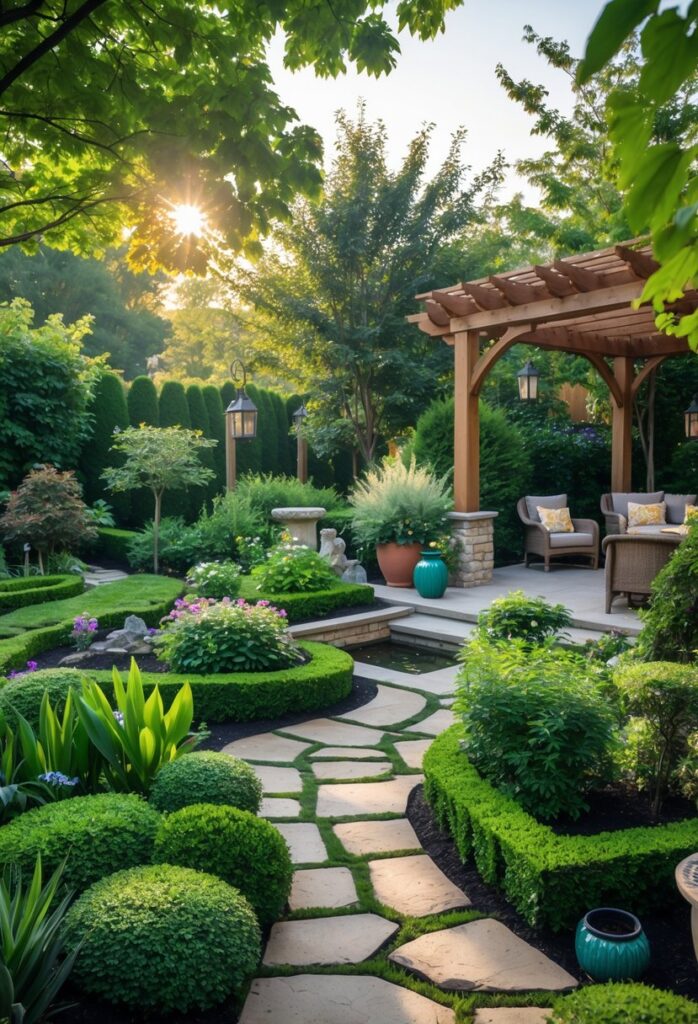
Creating a backyard oasis often starts with choosing the right plants and arranging them thoughtfully. Attention to scent, color, and texture can turn an ordinary yard into a space that feels inviting and calm. Incorporating fragrant flowers, well-planned beds, and soothing greenery are key to this transformation.
Flowers and Lavender for Fragrance
Flowers bring color and life to a backyard, but some also add fragrance, which enhances the overall experience. Lavender is a popular choice because it offers a pleasant scent and repels pests naturally. Planting lavender near seating areas or pathways allows its aroma to be easily enjoyed.
Other fragrant flowers like gardenias, daisies, and jasmine can complement lavender. Mixing these plants ensures a variety of blooms throughout the seasons. It is important to consider each flower’s sunlight and watering needs to keep them healthy and flourishing.
Designing Flower Beds and Potted Plant Displays
Flower beds provide structure and focal points in a garden. To design an effective flower bed, group plants with similar water and light requirements. This approach reduces maintenance and helps plants thrive.
Using raised beds or edging materials like stone can define flower beds clearly. Potted plants offer flexibility too. They can be moved based on the season or sun exposure and add vertical interest when placed on steps or stands. Choosing pot sizes that suit the plant’s root system is essential for good growth.
Ferns and Greenery for a Relaxing Atmosphere
Ferns and other green plants create a calming, shaded feel in a garden. They work well in spots with less direct sunlight where flowers might struggle. Ferns are low-maintenance and prefer moist, well-drained soil.
Adding diverse textures through different types of ferns and leafy plants enhances visual interest. Ferns like Boston, maidenhair, or sword varieties can each contribute unique looks. Greenery balances colorful flowers and helps soften hard edges and structures, making the backyard feel more natural.
For more ideas on creating lush backyard areas, see Best Plants for a Lush Garden Oasis.
Backyard Pathways, Flooring, and Structure
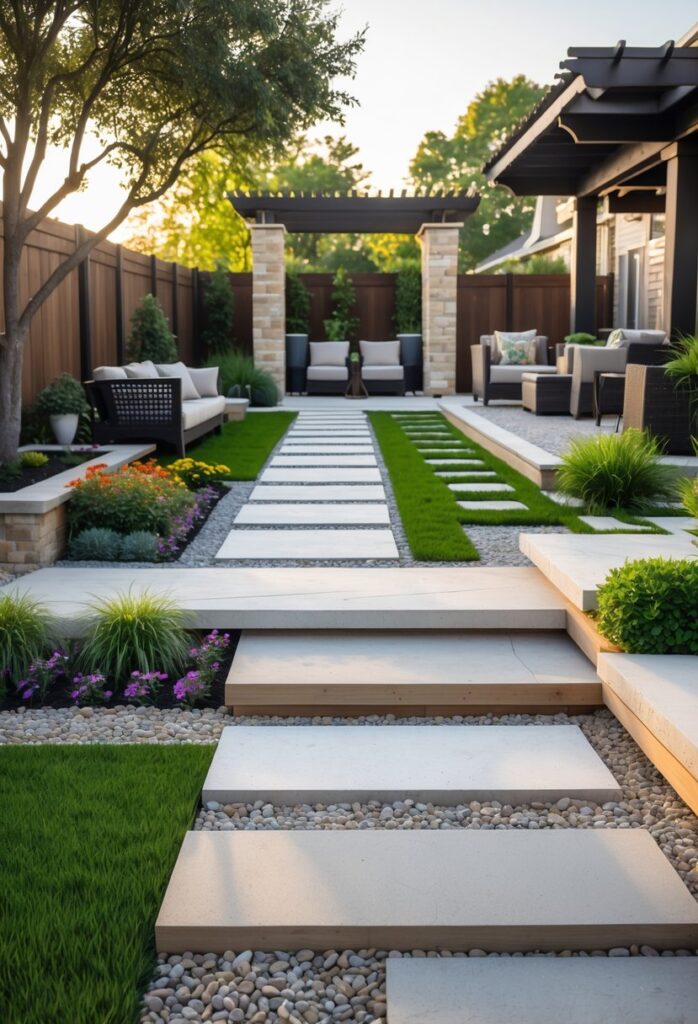
Creating pathways and hard surfaces in a backyard oasis helps organize the space and guides movement. Choosing the right materials and installation methods affects both the look and function. Durable options like stone, gravel, or wood offer flexibility for different designs and needs.
Stone and Gravel Pathways
Stone and gravel paths provide a natural, durable backdrop in a backyard. Stone pathways often use flagstone or irregular stones laid with space in between so grass or plants can grow, adding a relaxed, organic feel. The gaps also reduce costs by using fewer stones.
Gravel paths are affordable and easy to install. They work well in tight or winding spaces and can be lined with bricks or stone pavers for added definition. Gravel compacts over time, so using a mechanical compactor after installation helps keep stones in place and reduces shifting. Gravel also lets water drain easily, which prevents puddling.
Both materials offer versatility in shape and texture. They fit various landscaping styles and support low-maintenance planting around the edges to blend pathways with the garden.
Installing Pavers and Stepping Stones
Pavers and stepping stones give structure and style to backyard walkways. Square or rectangular pavers are often arranged in patterns like grids or staggered layouts. These clean lines suit modern and formal settings.
Stepping stones can be spaced with grass, mulch, or gravel between them, creating a visual rhythm and an informal look. Oversized stepping stones work well to make a bold statement in front yards or large gardens.
Installation usually begins with creating a compacted base layer to ensure stability. Sand or fine gravel is spread underneath to level the stones and avoid shifting. For permanent results, mortar can hold pavers in place, though it’s more labor-intensive.
Maintaining these pathways is simple—clearing debris and adjusting loose stones as needed keeps them safe and looking good.
Building a Wooden Deck
A wooden deck adds a functional, attractive zone in the backyard oasis. It serves as a platform for dining, seating, or lounging, connecting indoor and outdoor spaces.
Deck materials vary, including natural wood like cedar or composite boards for durability and low maintenance. Proper construction requires a strong frame with pressure-treated lumber and supports set on solid footings or piers to prevent shifting.
Designs can range from simple rectangular shapes to multi-level decks that add dimension and separate different outdoor areas. Adding steps and railings increases safety and accessibility.
A wooden deck complements garden paths well and can be linked by stepping stones or pavers, integrating the yard into one cohesive outdoor space.
Outdoor Dining and Entertainment Areas
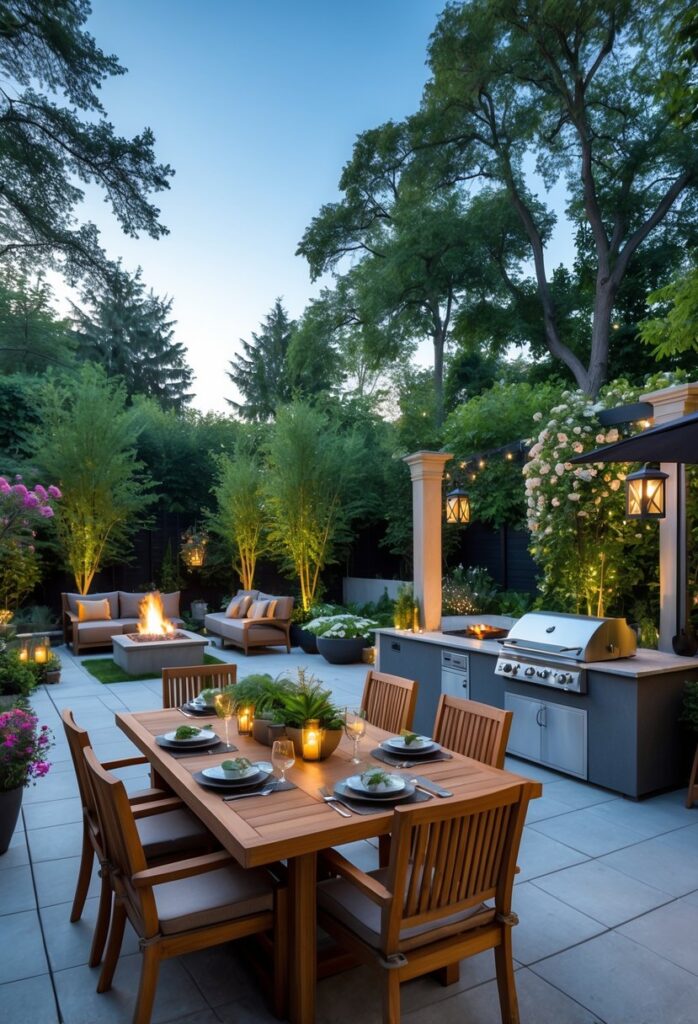
Creating functional and inviting spaces outdoors involves careful planning of seating, cooking, and decor. Thoughtful lighting, durable furniture, and artistic touches all contribute to an enjoyable experience.
Setting Up a Dining Area
A well-defined dining area outdoors should offer comfort and protection from the elements. Start with a sturdy table sized to fit your typical guest count. Weather-resistant materials like teak, metal, or synthetic wicker work well. Adding an outdoor rug can anchor the space and soften hard surfaces.
Seating options should prioritize comfort with cushions that resist UV damage and dry quickly. Consider shade with umbrellas or pergolas to shield from harsh sun. Proper lighting overhead or on nearby walls ensures evening meals are well-lit without glare.
Placing the dining area near the house or kitchen simplifies food service and cleanup.
Incorporating Outdoor Kitchens and Grills
Outdoor kitchens improve convenience and expand cooking options beyond simple grilling. A basic setup includes a grill paired with countertop space for food prep. Closed storage beneath helps keep utensils and supplies organized and protected.
Adding features like a side burner, mini-fridge, or sink enhances functionality. Task lighting over cooking areas is essential for safe food handling, especially after dark.
The layout should allow for smooth movement between cooking, serving, and dining zones to keep guests comfortable and the host efficient.
Enhancing with Sculptures and Decor
Artistic elements such as sculptures add personality and focal points to outdoor entertaining spots. These features can complement the natural environment or provide color and texture contrast.
Weatherproof materials like stone, metal, or treated wood endure outdoor conditions. Position sculptures where they are visible but do not block pathways or seating views.
Additional decor like garden plaques, decorative bowls, or fountains can echo the style of the sculptures and further personalize the space.
Together, these accents enrich the atmosphere without cluttering the area. For more ideas on combining dining and decor, see outdoor dining space ideas.
Ensuring Privacy and Tranquility

Creating a backyard oasis means making the space private and peaceful. This can be done by using the right fences, plant screens, and smart garden layouts. These elements help block unwanted views and reduce noise, turning the backyard into a calm retreat.
Fencing and Living Walls
Fences offer clear boundaries and security. Wooden fences provide a natural look and good privacy but need regular sealing to last longer. Metal fences are low maintenance and can be designed for a modern style, though they may not block sound as well.
Living walls, made of shrubs or dense plants like boxwood or arborvitae, act as natural fences. They grow thicker over time and add greenery that blends into the garden. Living walls give privacy while attracting birds and butterflies, creating a more lively, natural space.
Both options can also be combined for stronger privacy. For example, a wooden fence with climbing plants adds beauty as well as coverage.
Using Plant Screens for Privacy
Plants are great for softening views and providing privacy. Tall hedges like arborvitae or bamboo grow quickly and block neighbors’ sightlines. Bamboo offers a tropical feel with the bonus of low maintenance.
Climbing plants on lattices or trellises create vertical screens. Fast-growing vines such as jasmine, wisteria, or clematis add color and fragrance while forming a green privacy wall.
Ornamental grasses add texture and move gently in the wind, creating a peaceful vibe. Combining different plants in layers from tall trees to low shrubs builds a thick, natural barrier that reduces noise and offers year-round privacy.
Strategic Garden Layouts
Arranging a garden thoughtfully can enhance privacy and calm. Placing seating areas behind tall hedges or living walls gives a cozy, protected spot. Raised garden beds can act as natural barriers when filled with dense plants.
Using elements like water features can mask noise and add tranquility with gentle sounds. Paths and plant groupings create visual blocks and direct focus inside the yard, not outward.
Carefully layering plants by height—tall trees, mid-level shrubs, and flowers—builds dense cover. This technique both hides the yard from view and adds depth to the space, making it feel like a private retreat.
For more privacy ideas using plants and fences, check out 14 Backyard Perimeter Landscaping Ideas for Privacy.
Frequently Asked Questions

Creating a backyard oasis involves choosing the right designs, plants, lighting, and furniture. Many people also want ideas for adding water features and ways to do it all without spending too much.
What are the top trends in creating a backyard oasis this year?
Current trends focus on mixing natural elements like lush plants with structured outdoor rooms such as pergolas. Fire pits and cozy seating areas are popular for extending use into cooler evenings. Sustainable and easy-to-maintain features are also in demand.
How can I incorporate a water feature into my backyard design?
Water features can include fountains, small ponds, or flowing streams. Placing them near seating areas adds a calming sound and invites relaxation. Container water gardens or tabletop fountains work well for smaller spaces.
What are the best plants and trees to use for a backyard oasis?
Tall plants with full leaves help create privacy and a natural feel. Succulents are low-maintenance options that add texture. Shade trees like maple or oak provide relief from the sun and enhance the garden’s atmosphere.
What lighting options are recommended for an outdoor oasis area?
A mix of lighting works best. Porch lights and path lights improve safety. Dimmable lamps and candlelight create ambiance. Solar-powered accent lights highlight landscaping without adding to energy costs.
How can I create a backyard oasis on a budget?
Using gravel for patios and garden paths is affordable and low-maintenance. Focus on simple container gardens and weather-resistant textiles for comfort. DIY projects for seating or lighting also cut costs while personalizing the space.
What furniture pieces are essential for the ultimate backyard relaxation space?
Comfortable seating like hammocks or chaise longues make relaxing easy. Weatherproof cushions and pillows add extra comfort. Durable materials such as wrought iron or synthetic fabrics ensure the furniture lasts through weather changes.
